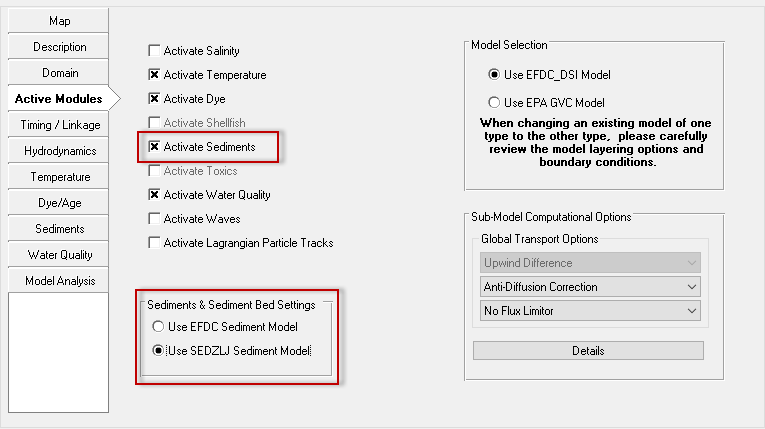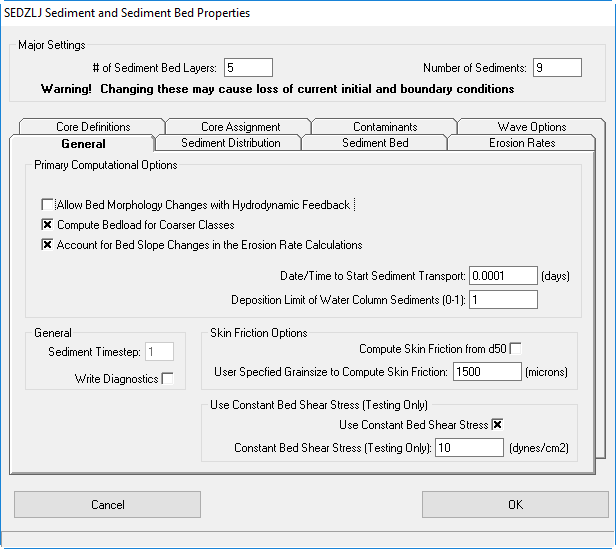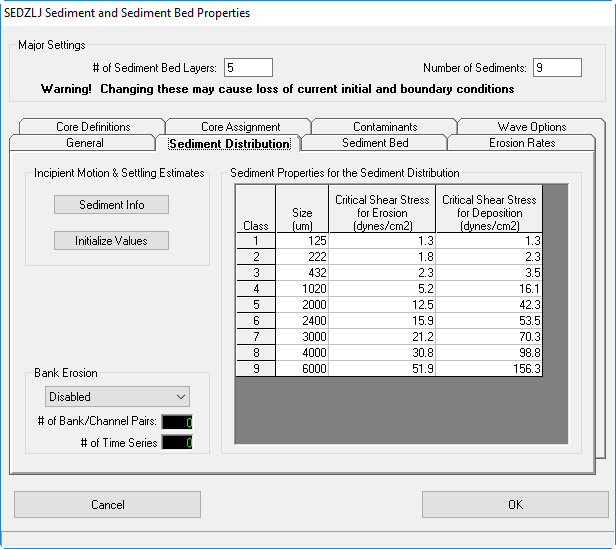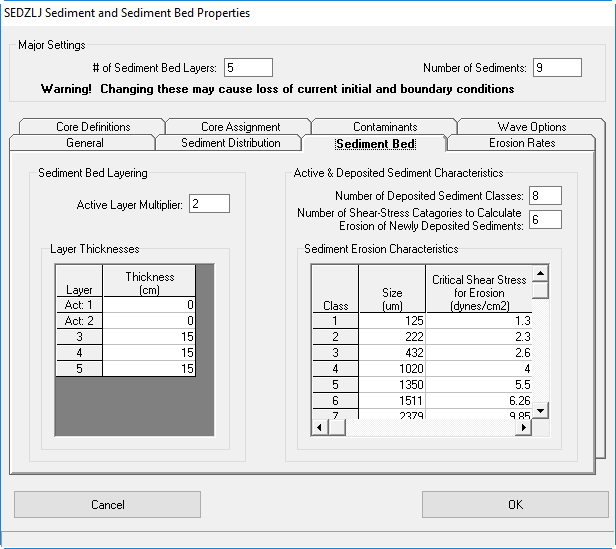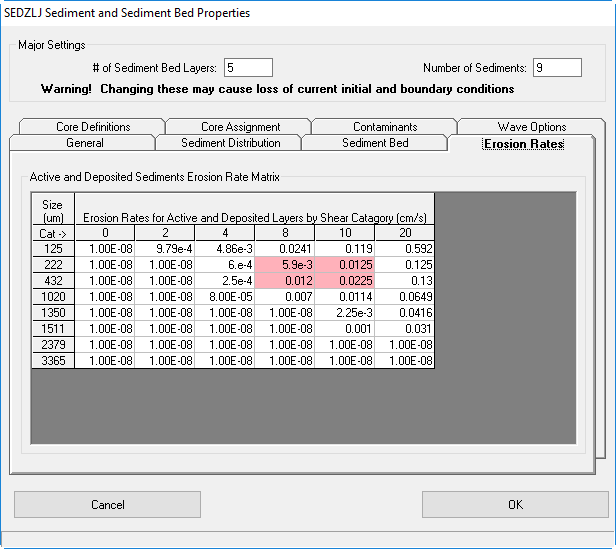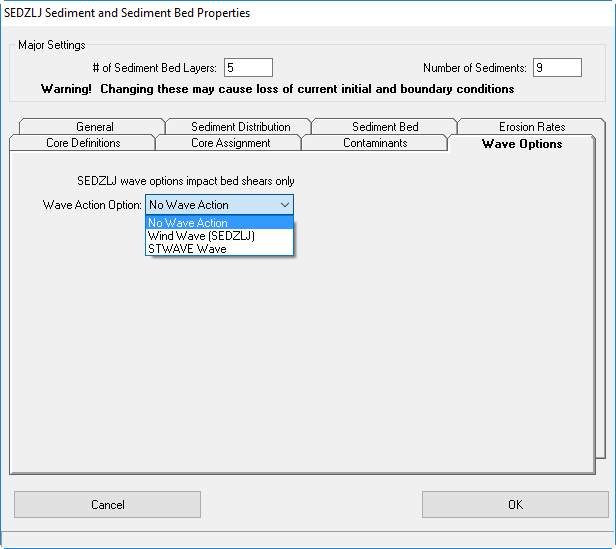The most state-of the-art sediment transport sub-model for EFDC is the SEDZLJ module that uses Sedflume data to determine erosion rates has been developed by Sandia National Laboratories. A detailed description of the SEDZLJ implementation in EFDC code is available in Sandia National Laboratories Environmental Fluid Dynamics Code: Sediment Transport User Manual (Thanh et al. 2008). The SNL approach, shown in Figure 1, accounts for multiple sediment size classes, has a unified treatment of suspended load and bedload, and appropriately replicates bed armoring. The resulting flow, transport, and sediment dynamics in the model is an improvement to previous models because this model directly incorporates site-specific erosion rate and shear stress data, while maintaining a physically consistent, unified treatment of bedload and suspended load.
Figure 1 Structure of the SEDZLJ sediment transport model.
As can be seen in Figure 1, SEDZLJ does not distinguish between cohesive and non-cohesive groups for erosion, deposition and transport. In this sub-model, any particle size less than 200mm is considered cohesive, and greater than 200mm is non-cohesive for calculating the probability of deposition. Also, the size classes greater than 200mm can be transported by bedload. The overall goal of SEDZLJ is to better represent sediment transport of typical sediments, which are a complex mixture of grain sizes with associated complex behavior. For this reason the SEDZLJ approach is now EPA’s preferred standard for contaminant sites.
EE can load most existing EFDC/SEDZLJ projects. Many of these existing SEDZLJ projects use slightly different formats, including those from SNL, USACE and AnchorQEA. Most of these existing projects can now be loaded by EE and saved out to run in EFDC+. EFDC+ uses a standard DSI format of the input files that was originally developed by Earl Hayter of USACE. DSI has developed a standalone AnchorQEA to EFDC+ converter since their files are completely non-standard EFDC formats. Contact DSI for more information about this.
Examples of the SEDZLJ input files can be found in Appendix B 21-24 . The primary input files for EFDC+ running the SEDZLJ sub-model are:
BED.SDF SEDZLJ control file
ERATE.SDF Core specific information
CORE_FIELD.SDF Assigns a cell to a core profile where each core has certain properties)
For both the conventional EFDC and SEDZLJ sediment models, the user may set Major Settings for the number sediment layers and number of sediments. However, these values should be changed with caution as it may result in loss of initial conditions and boundary conditions.
In the following sections, options available in the form SEDZLJ Sediment and Sediment Bed Properties are described. The SEDZLJ sediment model is turned on from the Active Modules tab on the main form. The user should first select the Activate Sediments check box and then select the sediment model as shown in Figure 2.
Figure 2 Active Module tab - SEDZLJ sediment transport sub-model.
1.1 General Settings Tab
The General tab is used for primary computational options for the SEDZLJ sub-model. In this tab, the user can turn on or off the simulation of SEDZLJ with the Simulate Sediment Transport Using the SEDZLJ Sub-Model check box. Other options include allowing bed morphology changes with hydrodynamic feedback, computing bedload for coarser classes, and accounting for bed slope change.
The Date/Time to Start Sediment Transport allows the user to run the model without erosion and deposition active until the model is stable. After model is stable, the sediment transport is fully activated from the specified time. The Deposition Limit of water Column Sediments is a value from 0 to 1. This represents the minimum fraction of sediment in the bottom water layer allowed to deposit in a single time step. Setting this to zero would cause 100% of the amount to be deposited in one time step, however, this is also dependent on the settling rate specified.
Figure 3 SEDZLJ sediment transport sub-model – General tab.
The user should refer to the SEDZLJ user manual for more information on Skin Friction Options and Use Constant Bed Shear Stress options.
1.2 Sediment Distribution Tab
The Sediment Properties for Sediment Distribution frame allows the user to set the class size, and critical shear stresses for erosion and deposition for each class. The units are in dynes/cm2 as SEDZLJ data is generally reported in CGS units, so EE maintains these units for consistency with the reported data. It should be noted that the process of erosion and deposition are handled differently in SEDZLJ. The redeposited grain size has a different shear stress.
In the Incipient Motion & Settling Estimates frame shown in Figure 4 there is a Sediment Info button which reports the critical shear stress for grain sizes used in the Sediment Properties for the Sediment Distribution table. These calculations for the critical shear stress are based on the equations from Van Rijn (Van Rijn, et al 1984) which use uniform grain size calculations and provided for the user’s information. These numbers do not have any impact in the actual model calculations. The Initialize Defaults button uses the values calculated here to provide initial values for the critical shear stresses for erosion and deposition, though the user would normally have measured data for these.
Figure 4 SEDZLJ sediment transport sub-model – Sediment Distribution tab.
1.3 Sediment Bed Tab
In the Sediment Bed tab shown in Figure 5, the Sediment Bed Layering frame allows the user to set the active layer multiplier as well as the layer thickness for all the layers.
The Active & Deposited Sediment Characteristics frame allows the users to specify the Number of Deposited Sediment Classes, as well as the Number of Shear Stress Categories to Calculation Erosion of Newly Deposited Sediments. Note that SEDZLJ allows for a different number of sediment classes for the sediment distribution and erosion characteristics.
Figure 5 SEDZLJ sediment transport sub-model – Sediment Bed tab.
1.4 Erosion Rates Tab
The Erosion Rates tab provides the user with the Active and Deposited Sediments Erosion matrix as shown in Figure 5. Highlighted cells provide a warning to the user that the erosion rate is not increasing with the increasing shear category, or that erosion rates are not decreasing with the increasing grain size. This is simply a QC check for the user and EFDC+ will still run despite the inconsistent values that have been input.
Figure 6 SEDZLJ sediment transport sub-model – Erosion Rates tab.
1.5 Core Definitions Tab
The Core Definitions tab, shown in Figure 7 is where the user defines the Number of SedFlume Cores, and then assigns the key parameters associated with each core. For example, if the user sets the number sedflume cores to two, then in the Core Parameter frame the drop-down will be populated with two cores. The names of these are user configurable and will appear in the information box in ViewPlan when looking at SEDZLJ Options | Core Zone.
For each layer in each core the user should set the critical shear stress and bulk density. The grain size distribution as a percentage also needs to be input in the first table. In the second table the user should input the initial bed erosion rates for each layer for each shear stress defined.
Figure 7 SEDZLJ sediment transport sub-model – Core Definitions tab.
1.6 Core Assignments Tab
In the Core Assignments tab shown in Figure 8 the user sets the different zones in the model grid for each core type. The DSI standard for this data is just the I, J map, and the core (EFDC looks for DSI in first line). There is a different format for this file for SNL. These file format type is set in the CORE_FIELD.SDF Format frame.
EE allows the users to specify the default core number for all the cells in the domain or specify the core definitions on a cell by cell basis. However, users can choose the default core number value when Allow core definition on a cell by cell basis is checked. EE will assign default values to cells which fall outside the region where core data is not available.
The Spatially Varying Core Assignment frame provides options for the user to set the appropriate cores to the rest of the model domain. The Use Nearest Neighbor Approach option uses an interpolation method to assign core numbers using the X, Y coordinates of the core.
Figure 8 SEDZLJ sediment transport sub-model – Core Assignment tab.
The Assign Core Numbers using Polygons with ID’s option is an ordered assignment based on the IDs in the P2D file. This file is begins with a single line header that is used as the ID of the polyline/polygon, which in this case is the core number. Next in this file comes the X, Y data to define the polygon. EE assigns the specified core number to the group of cells that lie inside the polygon. In some cases polygons may overlap, for example the user may make a polygon with core ID 4, which is inside that for core ID 2. In this case, core ID 4 will have precedence over core ID 2 and core ID 2 will not be used at all
1.7 Contaminants Tab
The Contaminants tab is not yet fully functional. Contaminant transport will be implemented in the next release of EE.
1.8 Wave Options Tab
The SEDZLJ wave options can be set by the user to impact the bed shears. The Wave Action Options dropdown provides three options: No Wave Action, Wind Wave (SEDZLJ), and STWAVE. While these options can use the EFDC+ internal wind waves, at this stage they only impact the boundary layer. It is anticipated in the future that SEDZLJ will be updated so that it can use the internal wind waves or external wave linkages in the EFDC wave sub-model, however, at this stage this option is not available.
If the standard SEDZLJ wind wave option is used then the EE wind wave option is not used. In this case the user must ensure they have all the correct files such as FETCH.INP refer to the SEDZLJ user guide for details on this format. Conversely, if the STWAVE option is selected then that correctly formatted STWAVE files are required.
Figure 9 SEDZLJ sediment transport sub-model – Wave Options tab.

